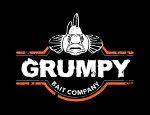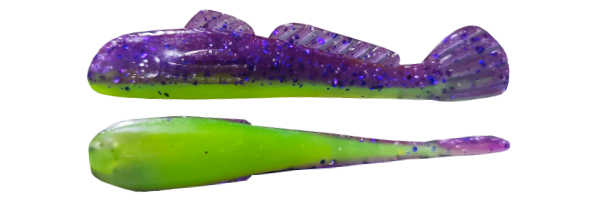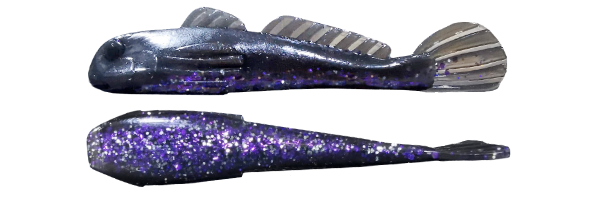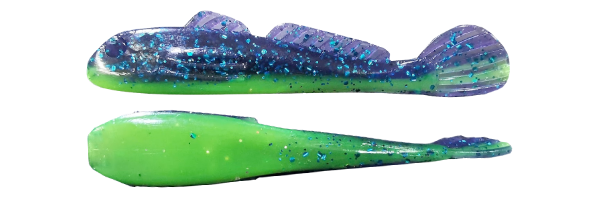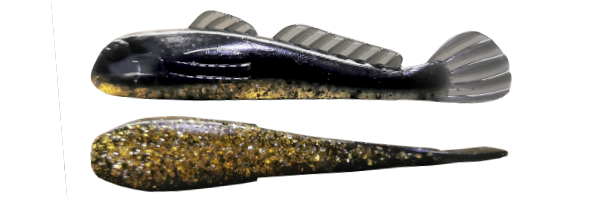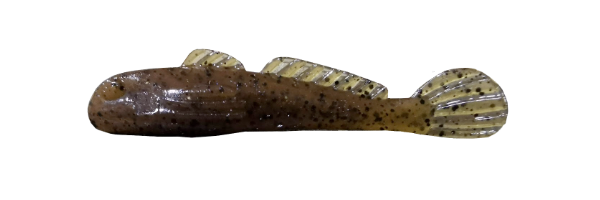INNOVATIVE NEW BAIT DESIGN FOR DETROIT RIVER ANGLERS
What They Are. Why You Need Them. How to Fish Them.
The Detroit River (Detroit) runs south between Lake St. Clair and Lake Erie and has been an extremely popular walleye fishing destination for both Canadian and US anglers alike. The Detroit has both resident and migratory walleye spreading its lengths and can be caught throughout the year however, the most popular walleye fishing time occurs between April and June. This time frame corresponds with pre-spawn, spawning and post-spawning periods. To catch walleye, anglers commonly jig plastic baits vertically from boats as well as casting and retrieving plastic baits from shore. Both techniques often result in great catches!
Over the years, anglers have used two primary bait styles - the 4" fluke (Figure 1.) and 4" worm-style bait (Figure 2.). These plastic baits are rigged with a 3/4oz, 5/8oz, or 1oz jig head and come in a wide variety of colors. While there are other techniques used on the river such as trolling body baits or hand-lining stick baits, jigging with fluke or worm-style baits has been the most popular choice for anglers over the years. However, with recent changes in Great Lakes ecology, a new food source is dominating fish feeding preferences.
Common Walleye Baits. Anything Missing?
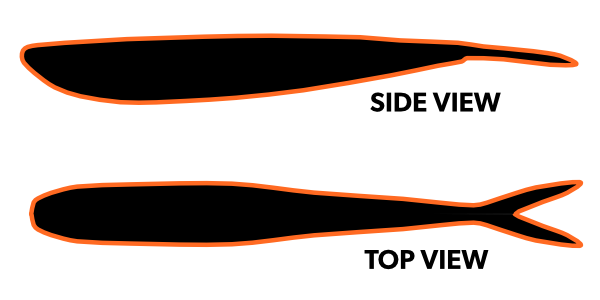
Figure 1.

Figure 2.

Figure 3.
What other naturally occurring, abundant food sources could entice fish to bite?
Walleye Food Sources: Why Goby Baits Just Make Sense
The majority of Detroit River walleye live most of their lives in one of three places - Lake Erie, Lake St. Clair or in the Detroit River itself. All three water bodies vary in terms of food sources, depth, water temperature, clarity, water velocity and structure however they all have healthy populations of round goby. Since walleye enter the Detroit from multiple locations during peak fishing periods, it is important that anglers understand walleye feeding preferences and prepare their bait selection accordingly.
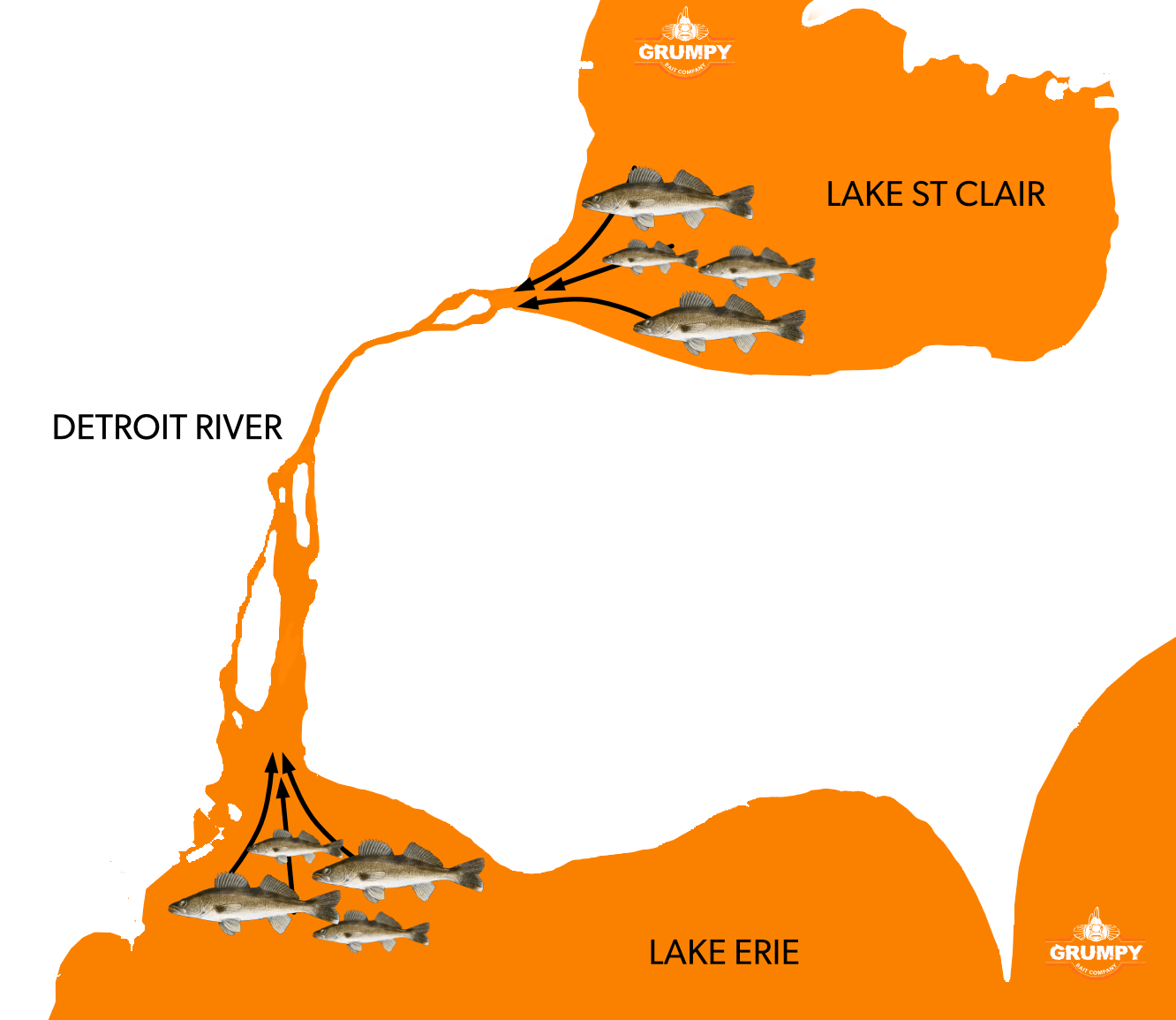
Lake Erie is the shallowest of Great Lakes and has a relatively low velocity, flowing from the west to east, draining into Lake Ontario down the Niagara River. Lake Erie walleye common food sources include yellow perch, freshwater drum, smelt, emerald shiner, round goby and other invertebrates.
In the 1970's and early 80's, when zebra mussels were not yet introduced, walleye were heavily focused on ambush feeding in a traditionally pelagic (open water) food web. During this time, trolling crankbaits resulted in much success as walleye were accustomed to hunting schools of smelt and other minnow-like fish. In 1988, with the accidental introduction of zebra mussels, Lake Erie was quickly transformed into a clear waterbody. Zebra mussels aggressively filtered zooplankton which was an important food source for mid-column prey such as smelt. This affected walleye two-fold. First, the overall reduction in smelt populations meant less food in the mid-water column for walleye to consume. Secondly, clear water conditions made it more difficult for walleye to ambush feed. This resulted in drastic reductions in walleye populations until the inadvertent introduction of the round goby.
Round goby (goby), introduced into Lake Erie in the 1990's brought new opportunity for walleye and transformed traditional open water feeding behaviour to a partially benthic (bottom feeding) food web. Why? Firstly, goby do not have swim bladders and forces them to scoot and hop along the bottom. Their inability to evade capture makes them an easy meal for juvenile walleye. Secondly, with a reduction in overall mid-water column food sources, coupled with the sheer explosion of goby populations, many species of fish including walleye, bass, freshwater drum and yellow perch added goby to their forage base. In the past, when smelt and shiners were abundant, walleye had the tendency to prefer minnow style baits. Now with the decline in those bait fish and an overall increase in goby populations, walleye more than ever are tuning into goby. This makes artificial goby baits an obvious choice for anglers fishing the Detroit River, St. Clair River, Thames River, Menominee River, Maumee River, Saginaw River and surrounding Great Lakes.
Lake St. Clair is a much shallower and warmer water body than Lake Erie, with a heavy presence of aquatic vegetation particularly during the summer months. This relatively low flow lake runs from the north and drains into the Detroit River in the south where the average flow rate increases to 1.5 knots and can go as high as 9.5 knots. In Lake St Clair, walleye tend to focus more heavily on yellow perch, freshwater drum, shiners, round goby and invertebrates. It is interesting to note that biologists first recorded the presence of goby in the St Clair River, and still today remains infested with them. Since then, goby continue to expand their footprint which has driven bait companies like the GRUMPY Bait Company to design and manufacture realistic, soft plastic goby baits that "match-the-goby-hatch" across various waterbodies in the Great Lakes Region. See Figures 4,5,6.
The Detroit River (Detroit) ranges between 18ft to 52ft and is considered a high-velocity waterbody. Unlike Lake Erie and Lake St Clair, fish living or entering the Detroit River and St. Clair River must acclimate to much different conditions that are driven by flow rates, water temperatures, water clarity and a fishes ability to quickly identify potential food sources. Both the Detroit River and St. Clair River have a smorgasbord of forage including minnows, goby and invertebrates. Juvenile walleye that hatched in the Detroit or St. Clair Rivers focus on consuming easy prey such as small minnows, small goby and invertebrates. They remain close to the bottom to conserve energy, find food and hide from predators. As they migrate to either Lake Erie or Lake St. Clair, juvenile walleye quickly learn how to identify food sources in high velocity aquatic environments. Among the easiest to identify is round goby. Their bulky body shape and habitual proximity to the lake/river bottom make it easy for walleye to consume compared to minnow style baits that are slender and more agile.
During pre-spawn, when the water temperature hits ~40F, walleye migrate into the river and start aggressively feeding. Anglers can take advantage of the hot action using a number of fishing techniques and bait styles. However during the spawn, things can slow down as fish refocused on reproduction - traditional baits can become less effective. During this lull, walleye are tight to the bottom, conserving most of their energy on reproduction. This is when anglers can take advantage of the natural tendency for walleye to attack and consume goby - a behaviour that has been imprinted into a walleye from a young age.
Variety of round goby color patterns found in the Great Lakes Region
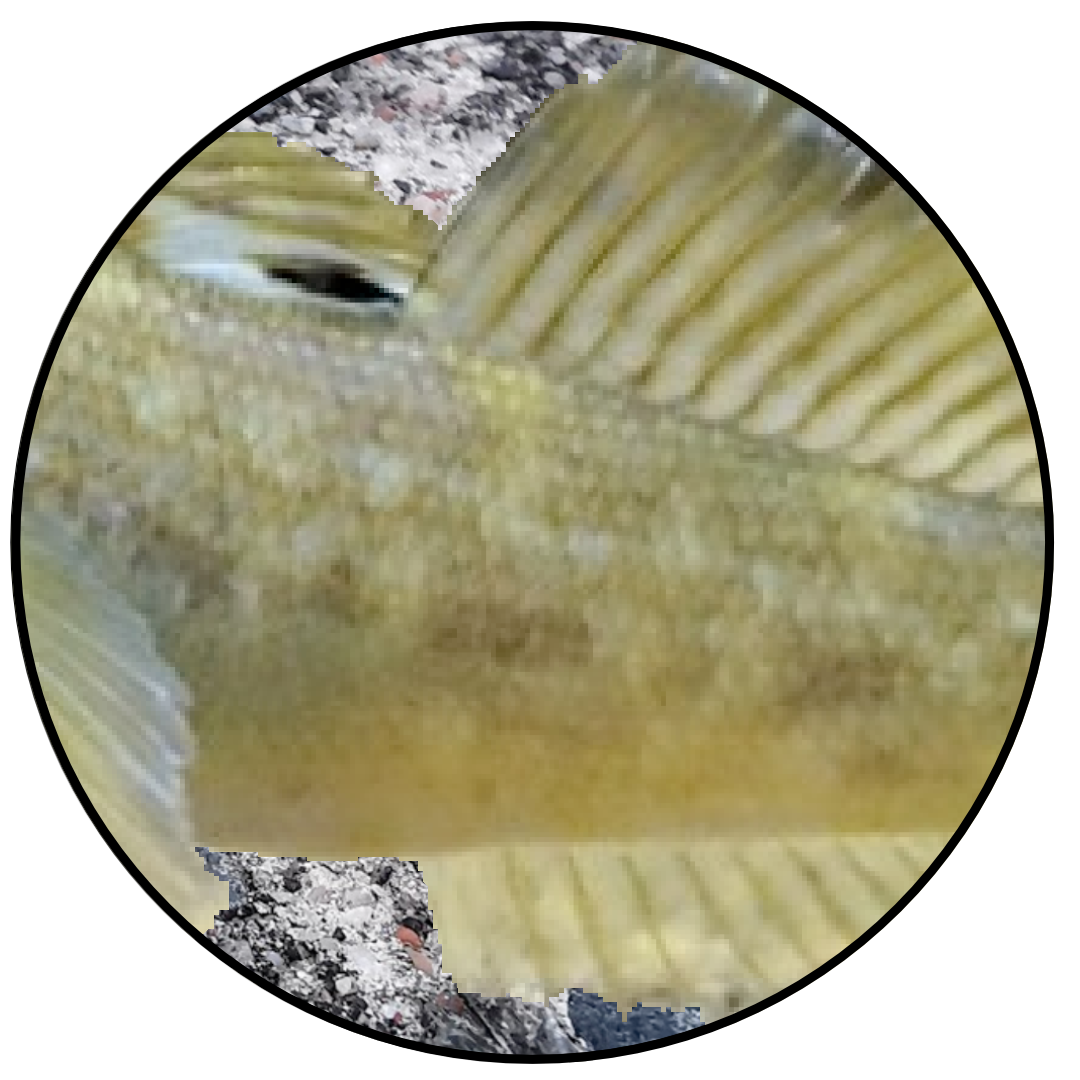

Figure 4.
GOLIATH Goby - Great Lake Goby (075)
Golden/blue/green colored goby found over light sand/shale/gravel/rocks bottom


Figure 5.
GOLIATH Goby - Lake St. Clair Goby (032)
Golden/brown/green colored goby often found over sand, sandy/silt and light gravel/rocks bottom
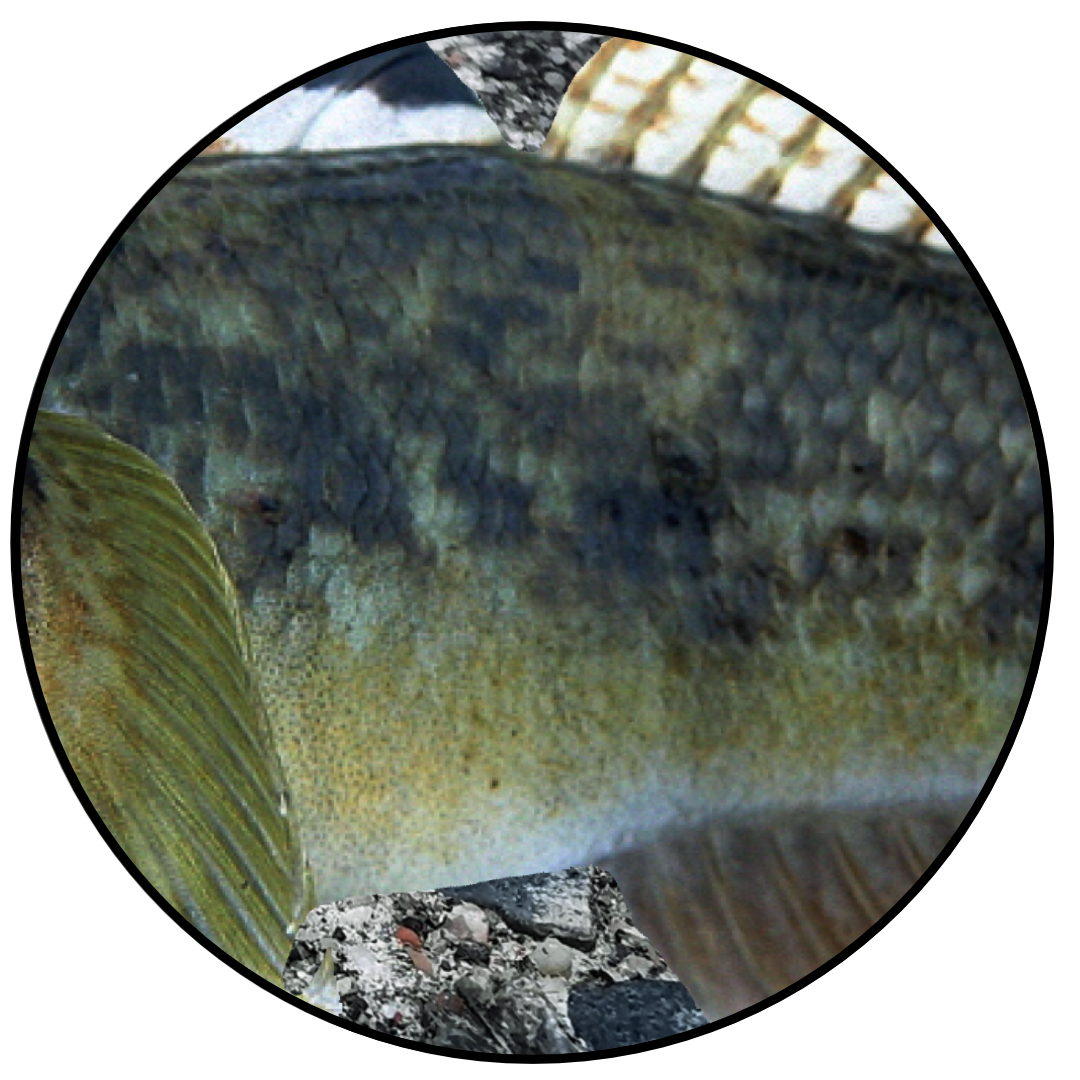
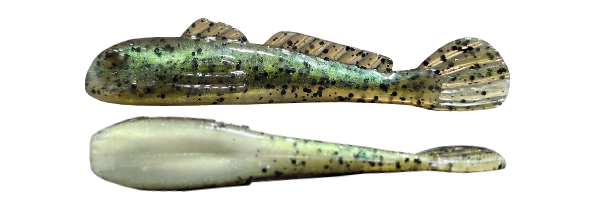
Figure 6.
GOLIATH Goby - Lake Simcoe (020)
Darker colored goby often found over rocks, boulders, gravel and vegatation-cover bottom
Bait Profile: How Picking the Right Style Bait Can Improve Your Odds
Detroit River walleye are truly amazing top predatory fish. Not only must they make split decisions as food races down the river, they must also contend with dirty water conditions, making it even more difficult to feed. Imagine a plate of food being placed in front of you and before you can taste the food, the plate is taken away. You can smell it - you can see it - but you can't eat it because it's gone. That is the life of a walleye feeding in fast flowing rivers. In a split second, walleye need to identify if the food source is edible or not. In the context above, this means walleye need to make an "eat - or - don't eat" decision before the food even gets to the table. That is an anglers challenge - to determine the best bait style that aligns to conditions and walleye feeding behaviour. For the Detroit, there are a number of factors including water clarity, water temperature, wind speed and direction, cloud cover and bait profile. For this section, we will focus on bait profile.
"Referring back to various walleye food sources, goby offer a great choice particularly in high flow environments. Why?"
First, round goby have elongated bodies with large heads, bulging eyes, two dorsal fins and a large vertically-aligned caudal fin. These visual characteristics have been imprinted in walleye throughout their lives, helping them to quickly identify goby profiles as a recognizable and easy-to-catch food source. They are a big target relative to other slim baits like worm of fluke (see Figures 7). In fact, GRUMPY Bait Company's GOLIATH Goby offers a 40% increase in overall cross-sectional, volumetric profile, compared to worm or fluke style baits. While some large, unrecognizable baits will spook walleye, goby are imprinted in their behaviour making the decision to bite in a split second a natural response. In addition, since walleye hug the bottom in fast moving waters to conserve energy, it naturally brings walleye closer to where goby are found - on the bottom. Not only is the shape and size of goby quickly identifiable, both goby and walleye naturally occupy the same space, making goby an easy and ideal bait choice.
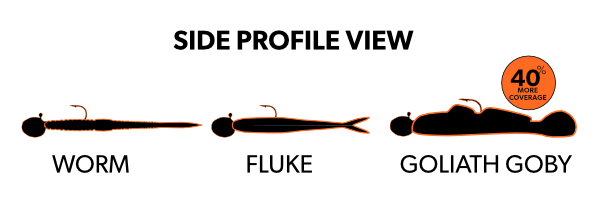
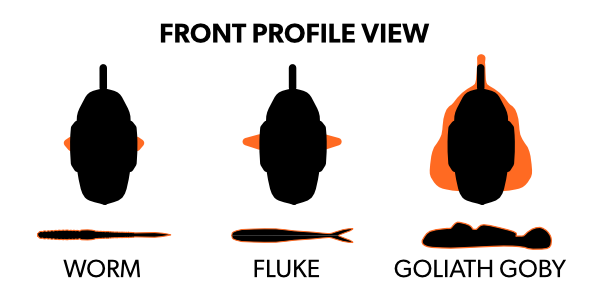
Water Clarity & Strike Zone: Changing Up Your Bait for the Conditions
In clear water conditions, fish can quickly distinguish prey at distance and chose to eat or not. Often is the case that clear water conditions cause fish to become more spooky and selective in what they eat. In these conditions, experienced Detroit River anglers quickly adjust to clear water conditions by changing their bait selection to more natural colors including blue/silvers, whites, browns and blacks. GRUMPY Bait Company now offers a wide selection of natural colored goby baits to help in these precise conditions, giving anglers highly realistic bait choices for finicky walleye.
In dirty water conditions, dark baits tend to produce more walleye. The primary reasoning for this is that dark baits offer a shadow-like appearance or silhouette in the water that is more noticeable than bright colors. Turbid water is full of particulate matter that prevents sunlight from hitting and reflecting off baits causing a dulling effect that not only hides colors but prevents fish from determining bait profile. Profile in dirty water is very important and there is no more recognizable profile than that of a round goby. Their natural elongated bodies, bulging heads and larger vertical caudal fin make them easy-to-recognize even in dirty water. Making artificial, anatomically-correct goby baits even more important in dirty water conditions.
Now, there is also another water color known as "slaughter-water". This water condition runs somewhere between clear and dirty water and offers the most ideal fishing conditions to catch even more walleye. Slaughter water conditions are ideally suited for hot colored baits that offer high visual contrast such as chartreuse/purple, limetreuse/black, hot orange/brown, black/silver etc. While mostly all bait colors will produced in these conditions, slaughter water is often hard to find. Most weekend warriors are at the mercy of whatever conditions they face on the weekends and is why having a variety of all colors is important.
KEY CONCEPTS:
- Clear water = larger strike zone
- Fish have more time to consider biting a bait or not
- Natural or bright colors are more noticeable
- More freedom to jig with larger strokes as strike zone is much bigger
- Scent and scent trails can still help to entice the bite
KEY CONCEPTS:
- Dirty water = small strike zone
- Fish have less time to consider biting a bait or not
- Silhouettes are more noticeable - darker is better
- Keep jigging to a minimal height to keep bait in the strike zone
- Scent, UV and GLOW all help to improve visibility
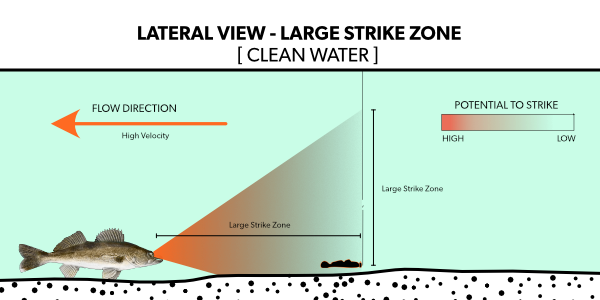
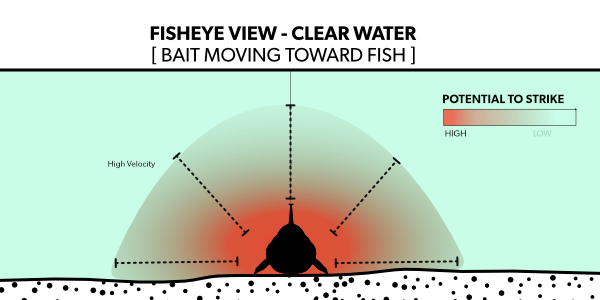
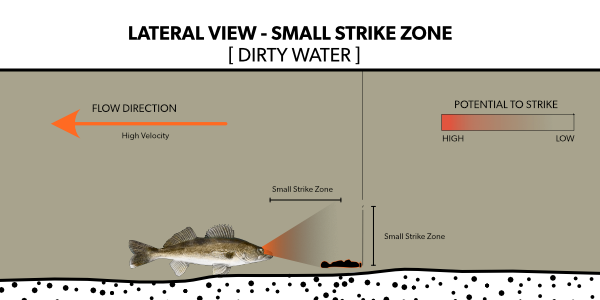
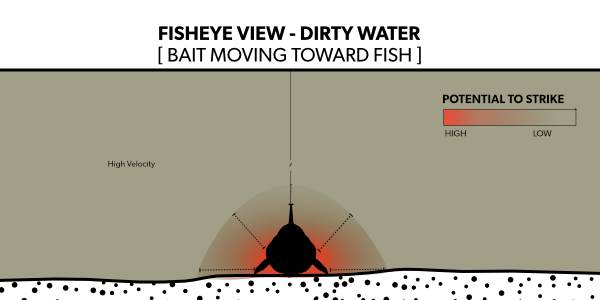
CLEAR WATER GOBY COLORS
SLAUGHTER WATER GOBY COLORS
DIRTY WATER GOBY COLORS
Water Clarity & Strike Zone: Changing Up Your Bait for the Conditions
Fishing large flowing rivers like the Detroit or St. Clair can offer some interesting challenges. First, presenting your bait close to the bottom can mean the difference between catching limits, or coming home skunked. Most anglers know that if you are jigging from a boat, it is critical that your line be directly below the boat. The ideal situation is your line is exactly 90 degrees from the surface.
The question many new anglers ask is, " Why is it so important to have your jig straight down?"
Most successful anglers will tell you that keeping your line straight down, jigging your bait directly on the bottom, allows for better jigging control, bite sensitivity, and hook setting ability. This is no easy task! Boat control requires constant adjustments to the trolling motor. Wind gusts, changes in river currents, avoiding other boats during the drift and contending with boat-wake can be a challenge. However, without good boat control, you are less likely to hook into many fish.
JIGGING TIP!
Try to "follow" your line by pointing your trolling motor to where your line enters the water surface. Make sure to maintain a constant distance from the nose of the boat to your line through continuous micro adjustments to the speed and direction of your trolling motor. Anglers commonly call this "chasing your line" and can really help you present your bait vertically. Watch out for other boats and buoys!
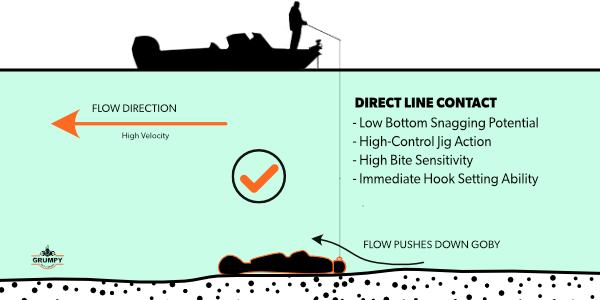
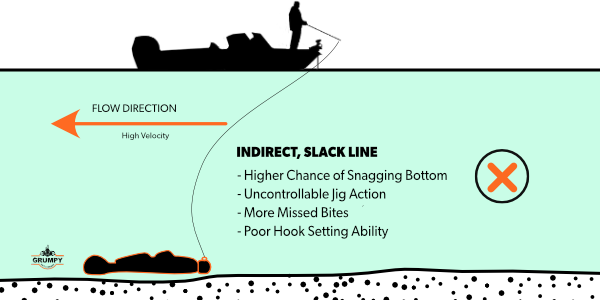
Jigging turbulent, high-velocity rivers can offer some major challenges. Often, these water conditions make it more difficult for anglers to keep constant contact with the bottom where walleye are found. Anglers using plastic baits need to identify the right jig weight coupled with the right bait profile. Bulky plastics with protruding appendages can cause baits to move unnaturally and uncontrollably in the water column, away from strike zone. During tournaments, every second your bait is out of the strike zone can mean the difference between winning or losing.
Summary of Why Goby Baits Are Ideal For Detroit River Anglers
While there are many styles of baits available for walleye anglers, some baits just make more sense when vertically jigging. Particularly with the invasion of round goby in the Great Lakes Region. Now, more than ever before, anglers are realizing that goby are an important food source for many fish species and are turning to goby-style baits. While Detroit and St. Clair river anglers have only had access to worm and fluke style baits over the years, GRUMPY Bait Company is now leading the way and providing anglers with innovative, realistic goby bait choices.
Goby profiles are highly recognizable to walleye in high-velocity river environments
Round goby have become an important food source for Great Lakes walleye
Goby baits with two dorsal fins and one large vertically-oriented caudal fin are important features
Goby baits in natural/realistic colors can improve catch ratio in clean water conditions
Goby baits in dark colors can improve catch ratio in dirty water conditions
GRUMPY Bait Company specializes in goby baits and produces more styles and colors than any manufacturer in North America
Learn more about GRUMPY Bait Company visit www.grumpybaits.com or email
